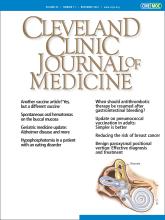
There is a shared weariness in response to discussions of mask-wearing, COVID-19 time warps, and vaccines. Over the past 2 years, most of us got a refresher course on vaccine development and implementation—if we had ever formally been taught or previously thought much about these topics at all. The delivery of mRNA-platformed vaccines to millions of people was a pharmaceutical development and public health tour de force, even if the rollout stutter-stepped at times. We can still do better in terms of total individuals “fully” vaccinated, though we do not yet know the implications of what fully vaccinated means.
COVID-19 vaccine discussions continue. I’ve almost given up on discussions with non-vaxer patients. If they haven’t bought in by now, rational discussion is unlikely to convince them. But I still try with some of my elderly or immunocompromised patients who have been influenced by the conspiracy theories and misinformation promulgated in their family or social circles. I lost enough patients in the early prevaccine days to not go silent into the night. Now, I count it a success if I can convince these at-risk patients to accept appropriate monoclonal antibody prophylactic therapy, or to promise to take a home test if they experience minimal symptoms and alert me if it is positive, and to consider taking antiviral medication.
Questions linger about the COVID-19 vaccines. How long will immunity last? How many boosters constitute full vaccinatation? Should we trust new vaccines even if they have only been modeled for efficacy? And are we overfocused on the humoral vaccine response?
But my focus here is not on COVID-19 vaccines. As we try to approach social and medical normalcy, it is late autumn, and we are preparing for influenza and pneumonia season. Influenza vaccination remains straightforward. Yearly strain changes in the circulating viruses lead to changes in vaccine composition in an effort to provide appropriate individual and herd protection. I still periodically have to explain to patients why they can’t get the flu from the flu vaccine, but these are not emotionally charged discussions. (As yet, I have heard no concerns about microchips in the flu shots.) There has been even less controversy in the patient community regarding vaccines against streptococcal pneumonia. In the medical community, there has been less controversy but more confusion regarding which pneumococcal vaccine to give when, and to which patient. For that, we have had cheat sheets posted on the wall next to our computer screens.
As newer vaccines against Streptococcus pneumoniae have arrived, so have confusing recommendations and guidelines for the sequence and timing of administration. And there seems to be limited understanding of the basis for the specific recommendations. In this issue, Cleveland Clinic Journal of Medicine deputy editor Craig Nielsen and colleagues summarize the guidelines for administration of pneumococcal vaccines.1
For decades, we have had the 23-valent pneumococcal polysaccharide vaccine (PPSV23, Pneumovax 23). It is safe and reasonably effective against pneumonia from S pneumoniae, but questionably effective against noninvasive infection.2 As a T cell-independent immunogen, it provides only a limited immune anamnestic response. The pneumococcal conjugate vaccine (PCV13) was formulated to engage T-cell activation with 13 strain-specific polysaccharide fragments (with overlapping specificity to strains covered by PPSV23) linked to a protein scaffold. Given along with PPSV23, there was a global decline in pneumococcal infections and carriage. The decline in carriage of S pneumoniae, likely the result of PCV13, has resulted in reduced transmission. However, serotypes not covered by PCV13 were still contributing significant morbidity. A newer vaccine (PCV20) covers 7 additional clinically relevant serotypes. This additional coverage was estimated to include about 30% of pneumococcal infections. PCV20 was documented to be safe and to elicit noninferior serotype immunity when compared with PCV13 and PPSV23.3 Interestingly, especially when viewed in the context of concerns about implementation of the newer bivalent COVID-19 vaccine without clinical outcome data, the efficacy comparisons of PCV20 leading to its regulatory acceptance were based not on clinical outcomes but rather on performance in a complicated functional ex vivo opsonization and phagocytosis assay.4 Immune efficacy—not a documented reduction in pneumococcal infections—was reported in patients without3 or with5 prior pneumococcal vaccination at 1 month after receiving PCV20. Coadministration of PCV20 with quadrivalent influenza vaccine or with an RNA-based SARS-CoV-2 vaccine did not adversely affect any of the immunologic responses.
After approval of the various PCVs, recommendations were offered for their timing of administration based on the methodologic structure of the clinical trials, which indicated additional immunologic benefit to patients receiving more than 1 vaccine. However, it was noted that local injection-site reactions were more common and more bothersome if different vaccines were given in temporal proximity. Nonetheless, it has been proposed that an interval of only 8 weeks, not a full year, can be considered when combining vaccines in patients at high risk for severe pneumococcal infection.6
An interesting and unexpected effect of the introduction of the PCVs is an apparent reduction in antibiotic-resistant pneumococcal isolates.5 But we still lack data on the long-term clinical efficacy of PCV20 and on the overall efficacy of current immunization practices in patients with disease-associated or iatrogenic immunosuppression. Nonetheless, as Nielsen et al point out in this issue,1 when it comes to vaccination, simpler is indeed better.
- Copyright © 2022 The Cleveland Clinic Foundation. All Rights Reserved.






